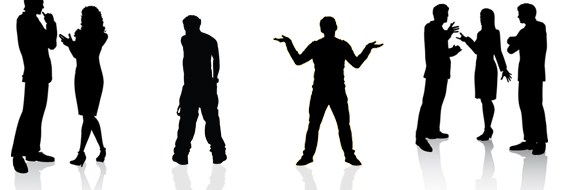The woman sits alone in a noisy cafe. Her legs are tightly crossed; her fingers clasp the edge of the table; her head is down. She speaks to the menu when she mumbles her order. She misses the smile the waiter sends in her direction. At a glance, you can guess how she is feeling. Her body language says it all.
Like it or not, our bodies send out messages constantly. Sometimes the message is clear. Other times, the message is conveyed more subtlety. Often we don’t even realize what our bodies are telling the world. But by familiarizing ourselves with a few basic nonverbal signals, we can improve our ability to read the body language of others, as well as control our own.
Our use of body language is largely unconscious. We get the message and we send the message but we really aren’t thinking about how we do it. To become more aware, says anthropologist David Givens, Ph.D., “you have to have some kind of strategy for it.”
Communication experts study such things as gestures, facial expressions, posture and voice, but Givens recommends a simpler approach. Director of the Center for Nonverbal Studies in Spokane, Wash., Givens suggests focusing on “the three most telling and expressive parts of the body:” the lips, the shoulders, and the fingertips and hands. These three parts, with their “great connections to the brain,” says Givens, reveal a person’s visceral, gut response to what’s going on. So watch for compressed lips, hunched shoulders and fidgety fingers, and move on from there to the bigger picture.
One of the easiest changes to make, she suggests, is to keep an open body. Women, more than men, shrink into their spaces. For example, “you don’t clench the fist, you open the fist. You don’t fold the hands in a tight hand grasp, you tent the fingertips. You don’t sit with your hands tightly folded, you drape them loosely over the arms of the chair. You smile.” “The open body represents power,” says Mindell, author of A Women’s Guide to the Language of Success, “and the closed body represents weakness or insecurity or hostility.”
Other changes are harder to make. Grimacing, fidgeting, extraneous movement these distracting gestures can be tough to eliminate. Mindell encourages clients to “concentrate on one less-than-perfect move at a time and resolve to change it.”
Eye contact, say the experts, is one of our weakest nonverbal skills and yet it is essential to establishing trust. Mindell points out that eye contact – touching someone with your eyes helps you “build a bridge between whatever separates you from your audience all those physical, psychological, cultural differences.”
With effort and self-discipline, anyone can improve their nonverbal communication skills. Admits Givens, “You have to go through a process where initially you get pretty self-conscious and you don’t know what to do and you become a statue, but you get over that pretty quickly. You get more natural.”
Watch people around you and mimic gestures and movements that work. “It’s like having a manual,” says Givens. A manual without words.
Gestures That Fail
- Standing rigid with your arms at your sides or clasping hands behind your back.
- Clutching your chest with both arms.
- Gripping the podium with white knuckles showing.
- Mismatching gestures and words: smiling inappropriately; shrugging or grimacing when making assertions or comments; laughing nervously.
- Moving extraneously in any way: playing or tugging at your hair, clothing, or face; swaying in place; fidgeting.
Gestures that Work
- Resting arms comfortably.
- Opening palms and arms .
- Enumerating with fingers (one-two-three, but don’t overdo this).
- Tenting or steepling the fingers.
- Sweeping arms from one side to the other to show movement or progress.
- Matching movements to your words and cutting out everything extraneous.
Adapted from A Woman’s Guide to the Language of Success: Communicating with Confidence and Power, Phyllis Mindell (Prentice Hall, 1995).”





